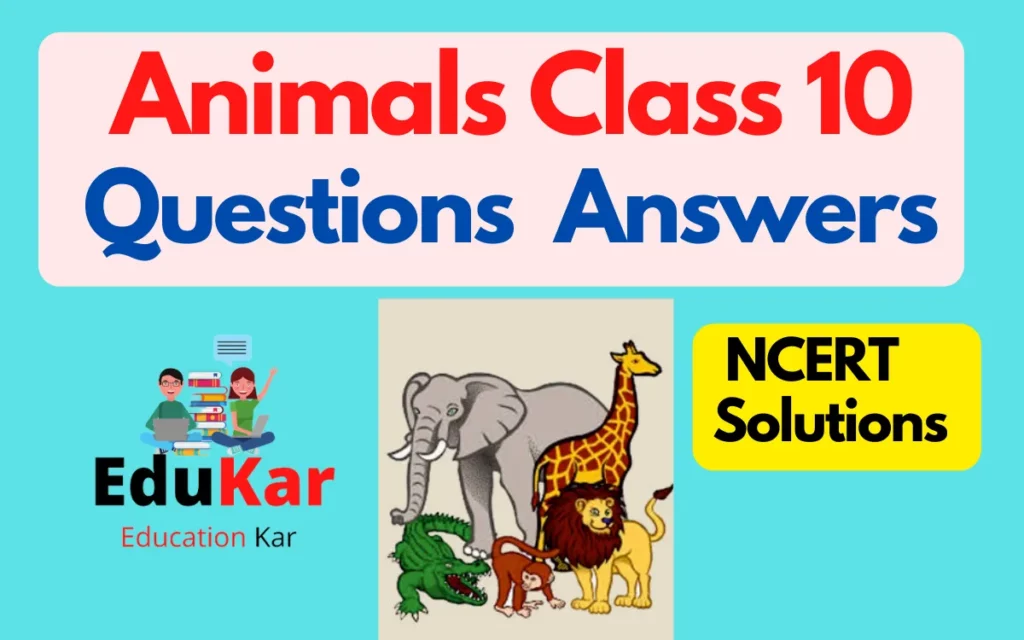| Name | The Inchcape Rock |
| Type | Poem |
| Class | 10th |
| Subject | English |
| Board | CBSE |
| Author | Carolyn Wells |

How to Tell Wild Animals: Question Answers Class 10 English
Question 1: Many animals can be identified according to th poet’s suggestion. Name the animals. Which does would you like to identify? Are there any lessons fro us from this poem?
Answer: The poet has listed down the ways of identifying seven animals in the poem, which are Asian Lion, the Bengal Tiger, The Leopard, Bear, Hyena, Crocodiles and Chameleons. As for me, I would like to identify teh Bear, the Bengal Tiger and the Leopard. However, putting my lifw on the line just to identify the tiger and the leopard doesn’t seem worth the risk, if I see a noble beast with black stripes on yellow, I’ll know the tiger, and the peppered spots will reveal the Leopard. The bear hug, I wouldn’t mind. The poet, using humour seems to warn readers against venturing too close to these animals.
Question 2: Does dying’ really rhyme with ‘lion’? Can you say it in such a way that it does?
Answer: No, ‘dyin’ does not rhyme with ‘lion’. If we speak the full word ‘dying’ it would not rhyme with lion. But ife we make the ‘g’ alphabet silent, it rhymes with ‘lion’.
Question 3: How doest the poet suggest that you identify the lion and the tiger? When can you do so, according to him?
Answer: The poet suggest that if a large and tawny beast roars and advances towards us in the jungle of East, then it is an Asian Lion. It can be identified while we are dying in fear. While roaming, if we come across a wild beast that has black stripes on a yellow body, it is a Bengal Tiger. It can be identified if he eats us.
Question 4: Every animal is unique and has some special characteristics. What tricks does the poet adopt in distinguishing various wild animals?
Answer: No doubts, every animal is unique. Every wild animal has his own special trait. Colour size and characteristics. The Asian Lion is found in the Jungles of the Eastern regions. It is a huge and mighty creature with brownish hide. The Bengal Tiger is a ‘noble’ and impressive wild animal. He has yellowish hide and black stripes all over it. He is very agile. The moment he sees its prey, he pounces upon it without showing any mercy. The bear is known by his strong and tight hug. It become rather difficult for a novice to distinguish among with animals. However, Hyenas and Crocodiles can be easily recognised. Hyenas come smiling merrily while crocodiles appear to be weeping. The chameleon is small creature like a Lizard. The Chameleon has no ears and doesn’t have even a single wing. You can find him sitting on a tree.
Question 5: “Humour is the best medicine for every ailment in life”. Explain.
Answer: Humour is infectious. When humour is shared, it binds people together and increases happiness. Humour stengthens our immune system, boosts our energy, diminishes pain and protects us from the damaging effects of stress. It is the pricesless medicine for every ailment in life. The poet, in the poem “How to Telll Aild Animals” creates humour by describing various beasts of prey. The way the poet explains the things is very funny yet interesting. The poet has depicted the wildlife very vividly and in a lively manner. While reading the poem, the readers enjoy the poet’s work and it leaves them refreshed and happy.
Question 6: Do you think the word ‘lept’ and ‘lep’ in the third stanza are spelt correctly? Why does the poet spell them like this?
Answer: No, the word ‘lept’ and ‘lep are spelt incorrectly. The correct spellings are ‘leapt’ and ‘leap’ respectively. The poet has spelles them like this to maintain the rhythm of the poem.
Question 7: Do you know what a ‘bearhug’ is? It’s a friendly and strong hug-such as bears are thought to give, as they attack you.
Answer: A ‘bearhug’ is the tight embrace of bear with both hands when it kills its prey. Yes, there are similar expressions and popular ideas about wild animals in every language.
Question 8: According to the poet of “How to Tell Wild Animals”, how will you know that is an Asian Lion?
Answer: Asian Lion is a large and brownish wild animal. It roars while killing his prey.
Question 9: According to the poet of “How to Tell wild Animals”, how does leopard behave when he meets a person?
Answer: When leopard meets a person, it leaps over him at once.
Question 10: Who is the noble wild beast according to the poet of “How to Tell Wild Animals”?
Answer: The noble wild beast is the Bengal Tiger.
Question 11: Look at the line “A novice might nonplus”. How would you write this correctly? Why is the poet’s incorrect line better in the poem?
Answer: The line “A novice might noonplus” ca also be written as “A novice might be nonplussed”. The poet’s incorrect line is better in the poem because it maintains the rhyme cheme of the poem.
Question 12: Can you find other examples of poet talking liberties with language, either in English or in your own language? Can you find examples of humorous poems in your own language?
Answer: Yes, we can find other examples of poet talking liberties with language. Poet take such liberties with language in order to create proper rhyming and maintain the interest of the reader. For example, one of teh humorous poem is “Trees” written by Joyce Kilmer. In this poem the word ‘prest’ is used instead of ‘pressed’ to rhyme with ‘breast’.
Question 13: Much of the humour in the poem arises from the way language is used, although the ideas are funny as well. If there are particular…….
Answer: The poet has kept the language of the poem very simple and humorous. The lines from the poem that appears to be funny are “A noble wild beast greets you”. The idea that a wild beast is going to welcome you is quite funny, and is unlikely that a ferocious animal like tiger would do that. The language in the line, “He’ll only lep and lep again”, is also very humorous. The word ‘lep’ means to jump, which the poet has used to maintain the rhyme scheme and its humour
Question 14: How does the poet distinguish the Hyena from Crocodile?
Answer: A Hyena is an animal who can laugh. A Crocodile is a creature who shed tears.
Question 15: According to the poet of “How to Tell Wild Animals”, what two things does a chameleon not have?
Answer: A chameleon does not have ears and wings.
Question 16: The poet has successfully used humour to be able to ‘tell’ or identify ‘wild animals’. How do you think we need lots of it in our daliy life?
Answer: Humour is the fuel of life. Without it, it would become difficult to continue living. Today, the life of a common man is typically mired in stressed, tension, problems and sadness. It is amazing how the smallest problems may take on epic proportions for a common person. In such a situation, it becomes necessary to have a little humour in life. It gives us the much0needed respite from our monotonous routine and helps us face life more positively. Thus, the poet’s successful use of humour helps living our minds and brings a smile on our faces.
Question 17: What is the theme of the poem “How to Tell Wild Animals”?
Answer: The poem “How to Tel Wild Animals” by Carolyn Well revolves around the dangerous ways to identify the wild and ferocious animals. The poet tries to distinguish one animal from the other in a humorous way. The poet suggest that is is very risky to be in such a close proximity to these wild beats.





![A Tiger in the Zoo Question Answer [Class 10] A Tiger in the Zoo Question Answer](https://edukar.in/wp-content/uploads/2022/12/A-Tiger-in-the-Zoo-Question-Answer-1024x640.webp)

![How The Dog Found Himself a New Master Question Answer [Class 6 English Unit 2] How The Dog Found Himself a New Master Question Answer](https://edukar.in/wp-content/uploads/2023/01/How-The-Dog-Found-Himself-a-New-Master-Question-Answer-1024x640.webp)


![Natural Vegetation and Wildlife Class 9 Questions Answers [Class 9 Geography Chapter 5] Natural Vegetation and Wildlife Questions Answers](https://edukar.in/wp-content/uploads/2023/01/Natural-Vegetation-and-Wildlife-Questions-Answers--1024x640.webp)
![Packing Class 9 Questions and Answers [Class 9 English Beehive Chapter 7 ] Packing Class 9 Questions and Answers [Class 9 English Beehive Chapter 7 ]](https://edukar.in/wp-content/uploads/2023/01/Packing-Class-9-Questions-and-Answers-1024x640.webp)
![My Impression Of Assam Question Answer [Class 11 English Chapter 9] My Impression Of Assam Question Answer](https://edukar.in/wp-content/uploads/2022/12/My-Impression-Of-Assam-Question-Answer-1024x640.webp)
![A House Is Not A Home Question Answer [Class 9 English Moments Chapter 8] A House Is Not A Home Question Answer](https://edukar.in/wp-content/uploads/2023/01/A-House-Is-Not-A-Home-Question-Answer-1024x640.webp)
![The Poetry of Earth Question Answer 2023 [Short & Long] The Poetry of Earth Question Answer](https://edukar.in/wp-content/uploads/2023/01/The-Poetry-of-Earth-Question-Answer-1024x640.webp)
![Asleep in the Valley Questions and Answers 2023 [Class 12-English] Asleep in the Valley Questions and Answers](https://edukar.in/wp-content/uploads/2022/12/Asleep-in-the-Valley-Questions-and-Answers-1024x640.webp)
